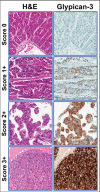Evaluating clinical and prognostic implications of Glypican-3 in hepatocellular carcinoma
- PMID: 27655712
- PMCID: PMC5342524
- DOI: 10.18632/oncotarget.12066
Evaluating clinical and prognostic implications of Glypican-3 in hepatocellular carcinoma
Abstract
Hepatocellular carcinoma (HCC) is one of the most deadly cancers worldwide. In patients with HCC, histopathogical differentiation is an important indicator of prognosis; however, because determination of HCC differentiation is difficult, the recently described immunohistochemical (IHC) marker glypican3 (GPC3) might assist in HCC prognostication.The goal of our study was to investigate GPC3's IHC staining pattern and define the relationship between its expression and patients' clinicopathologic features and overall survival. We retrieved clinical parameters from 101 pathologically diagnosed HCC patients' medical records and classified these patients into 4 clinical score categories (0-3) based on increasing GPC3 staining intensity and the percentage of stained tumor cells in their resection and biopsy specimens. Histopathological samples were well, moderately, and poorly differentiated in 33, 22, and 12 patients, respectively, and the GPC3 expression rate was 63%, 86%, and 92%,respectively. The median overall survival was 49.9 months (confidence interval (CI): 35.3-64.6 months) for clinical scores 0-1 and 30.7 months (CI: 19.4-41.9 months) for clinical scores 2-3. This difference was not statistically significant (P = .06) but showed a strong trend. In conclusion, a greater GPC3 expression is associated with a worse HCC prognosis and may be a promising prognostic marker.
Keywords: glypican-3; hepatocellular carcinoma; immunohistochemistry.
Conflict of interest statement
The authors declare no conflicts of interest.
Figures




References
-
- Ferlay J, Soerjomataram I, Dikshit R, Eser S, Mathers C, Rebelo M, Parkin DM, Forman D, Bray F. Cancer incidence and mortality worldwide: sources, methods and major patterns in GLOBOCAN 2012. Int J Cancer. 2015;136:E359–386. - PubMed
-
- Yeh CN, Lee WC, Chen MF. Hepatic resection and prognosis for patients with hepatocellular carcinoma larger than 10 cm: two decades of experience at Chang Gung memorial hospital. Ann Surg Oncol. 2003;10:1070–1076. - PubMed
-
- Poon RT, Fan ST, Wong J. Selection criteria for hepatic resection in patients with large hepatocellular carcinoma larger than 10 cm in diameter. J Am Coll Surg. 2002;194:592–602. - PubMed
-
- Borscheri N, Roessner A, Rocken C. Canalicular immunostaining of neprilysin (CD10) as a diagnostic marker for hepatocellular carcinomas. Am J Surg Pathol. 2001;25:1297–1303. - PubMed
-
- Wang L, Vuolo M, Suhrland MJ, Schlesinger K. HepPar1, MOC-31, pCEA, mCEA and CD10 for distinguishing hepatocellular carcinoma vs. metastatic adenocarcinoma in liver fine needle aspirates. Acta Cytol. 2006;50:257–262. - PubMed
MeSH terms
Substances
LinkOut - more resources
Full Text Sources
Other Literature Sources
Medical

